Unit 5 Learning from nature Using language Grammar 课件(共39张)外研版(2019)选择性必修 第三册
文档属性
| 名称 | Unit 5 Learning from nature Using language Grammar 课件(共39张)外研版(2019)选择性必修 第三册 | 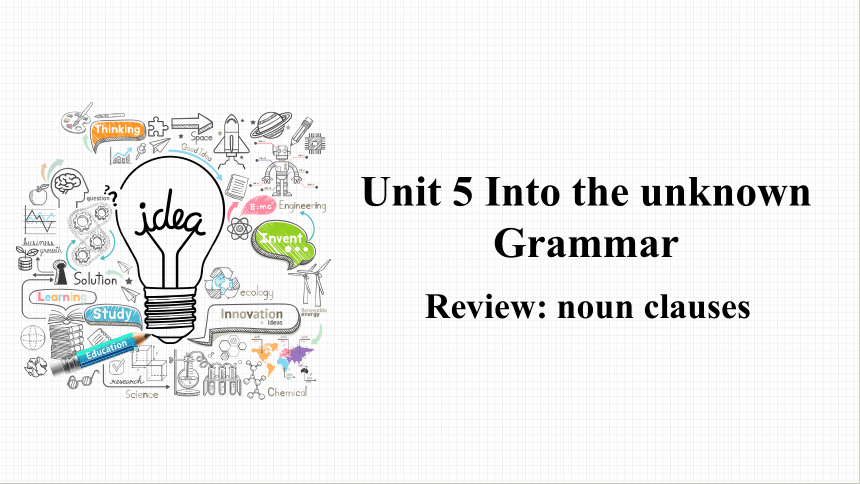 | |
| 格式 | pptx | ||
| 文件大小 | 12.0MB | ||
| 资源类型 | 教案 | ||
| 版本资源 | 外研版(2019) | ||
| 科目 | 英语 | ||
| 更新时间 | 2025-04-27 14:56:35 | ||
图片预览

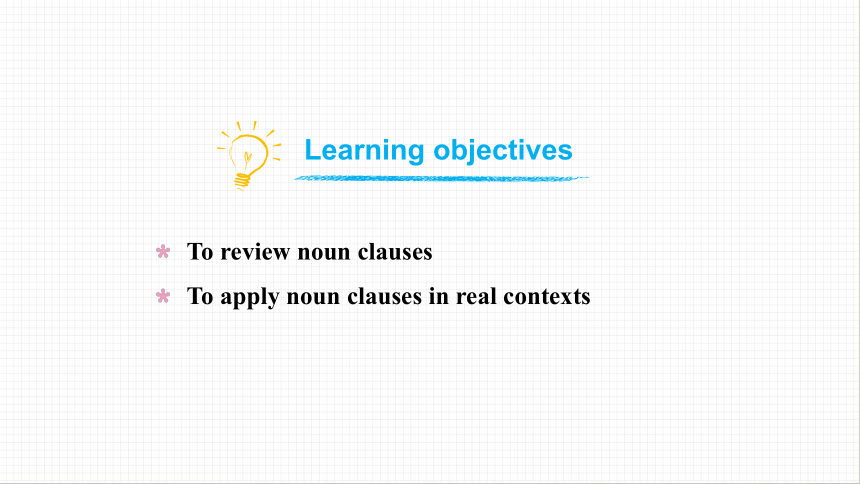
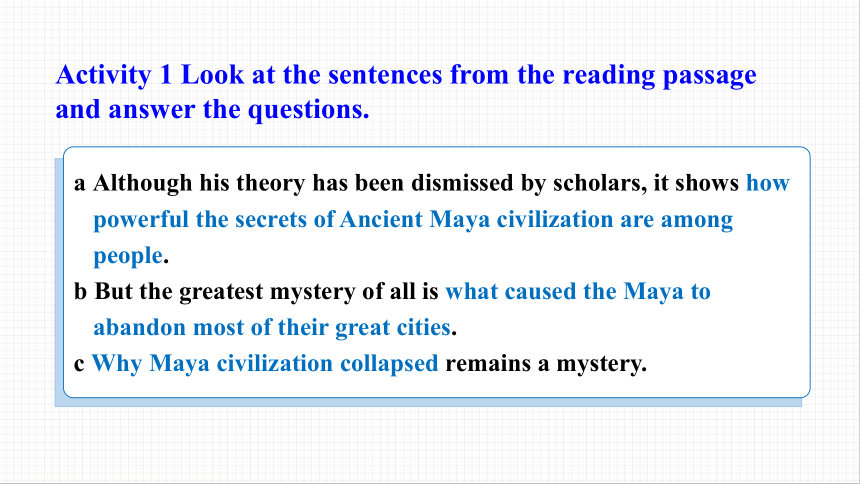
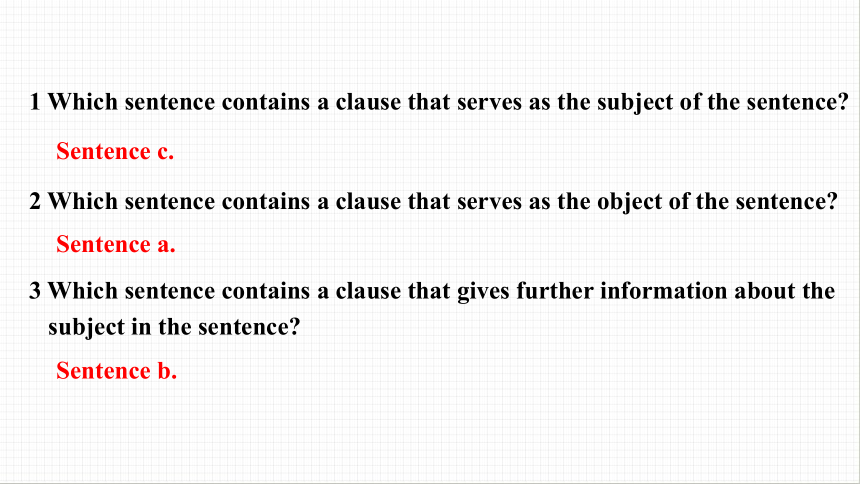
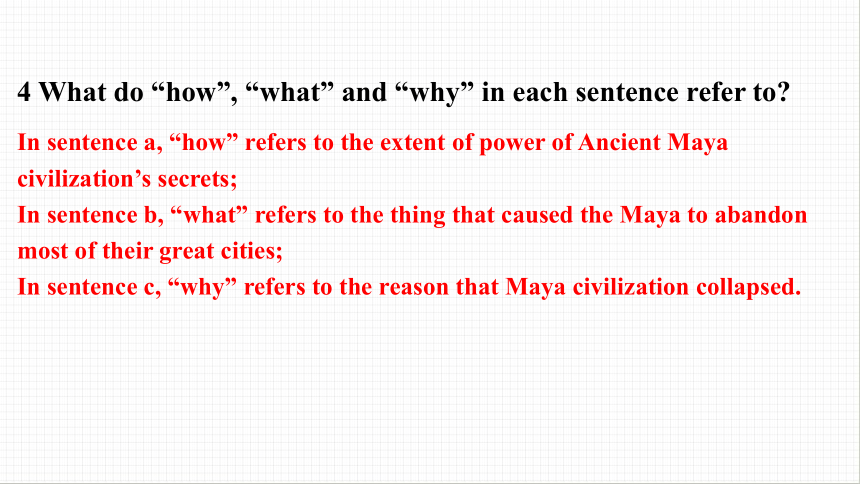
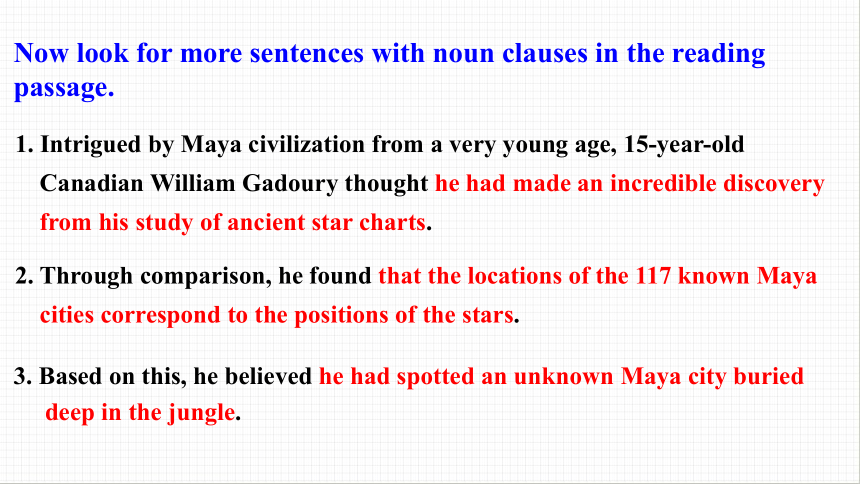
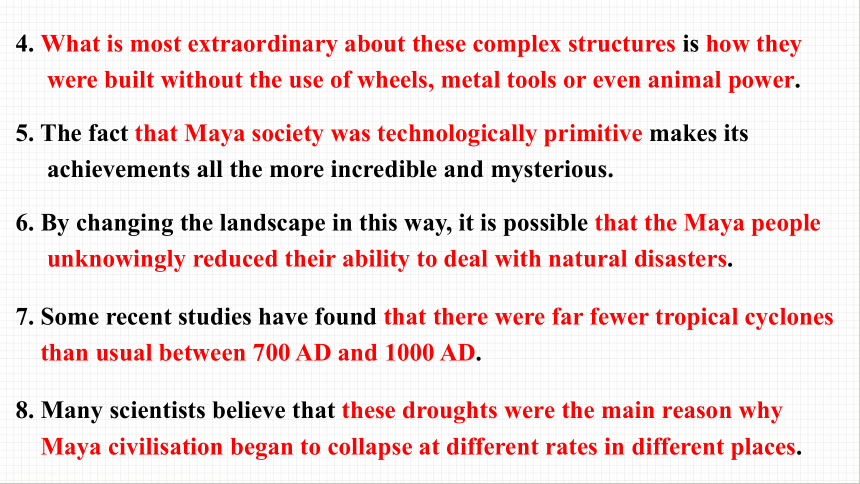
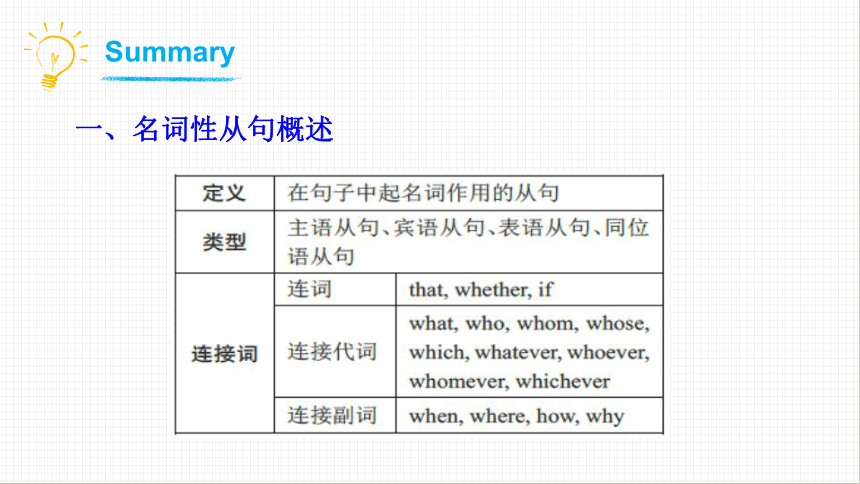
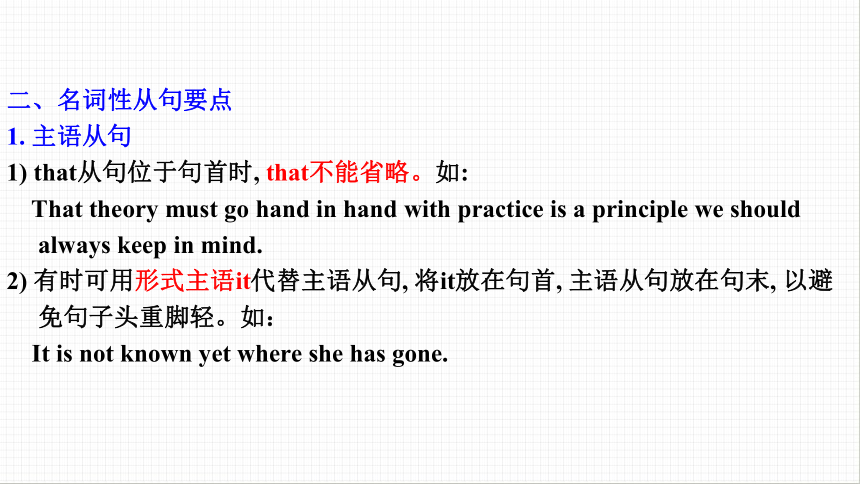
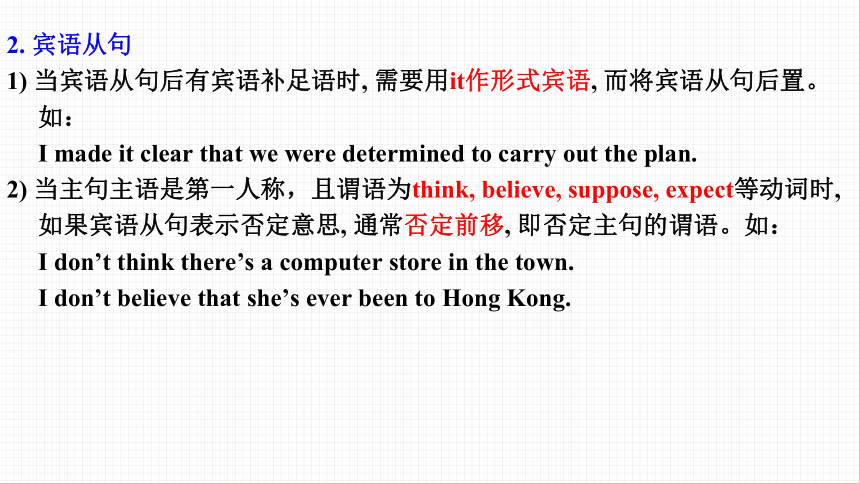
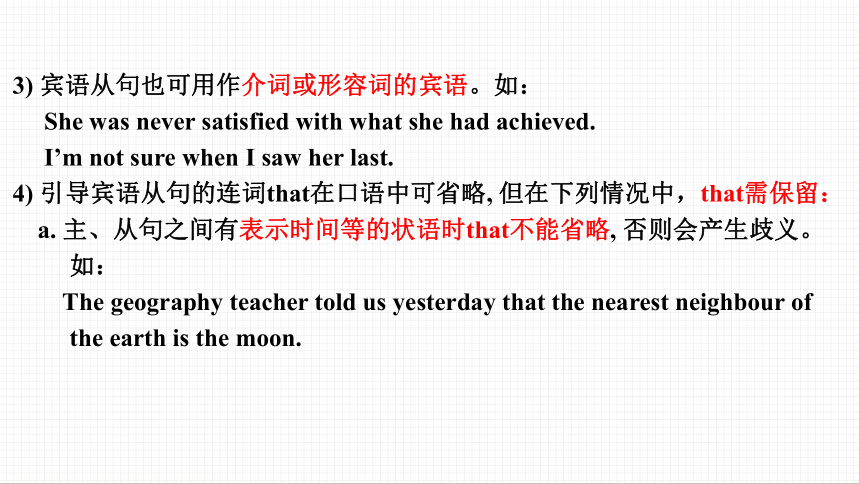
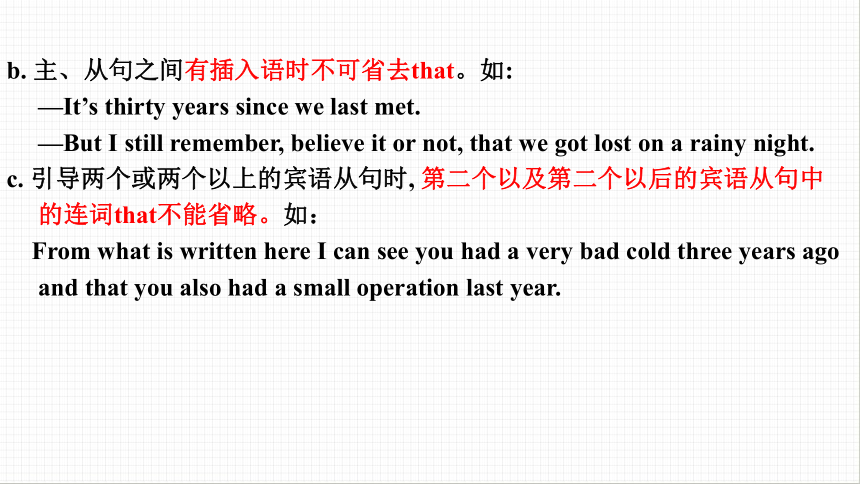
文档简介
(共39张PPT)
Review: noun clauses
Unit 5 Into the unknown
Grammar
To review noun clauses
To apply noun clauses in real contexts
Learning objectives
Activity 1 Look at the sentences from the reading passage and answer the questions.
a Although his theory has been dismissed by scholars, it shows how powerful the secrets of Ancient Maya civilization are among people.
b But the greatest mystery of all is what caused the Maya to abandon most of their great cities.
c Why Maya civilization collapsed remains a mystery.
1 Which sentence contains a clause that serves as the subject of the sentence
2 Which sentence contains a clause that serves as the object of the sentence
3 Which sentence contains a clause that gives further information about the subject in the sentence
Sentence c.
Sentence a.
Sentence b.
4 What do “how”, “what” and “why” in each sentence refer to
In sentence a, “how” refers to the extent of power of Ancient Maya civilization’s secrets;
In sentence b, “what” refers to the thing that caused the Maya to abandon most of their great cities;
In sentence c, “why” refers to the reason that Maya civilization collapsed.
Now look for more sentences with noun clauses in the reading passage.
1. Intrigued by Maya civilization from a very young age, 15-year-old Canadian William Gadoury thought he had made an incredible discovery from his study of ancient star charts.
2. Through comparison, he found that the locations of the 117 known Maya cities correspond to the positions of the stars.
3. Based on this, he believed he had spotted an unknown Maya city buried deep in the jungle.
4. What is most extraordinary about these complex structures is how they were built without the use of wheels, metal tools or even animal power.
5. The fact that Maya society was technologically primitive makes its achievements all the more incredible and mysterious.
6. By changing the landscape in this way, it is possible that the Maya people unknowingly reduced their ability to deal with natural disasters.
8. Many scientists believe that these droughts were the main reason why Maya civilisation began to collapse at different rates in different places.
7. Some recent studies have found that there were far fewer tropical cyclones than usual between 700 AD and 1000 AD.
一、名词性从句概述
Summary
二、名词性从句要点
1. 主语从句
1) that从句位于句首时, that不能省略。如:
That theory must go hand in hand with practice is a principle we should always keep in mind.
2) 有时可用形式主语it代替主语从句, 将it放在句首, 主语从句放在句末, 以避免句子头重脚轻。如:
It is not known yet where she has gone.
2. 宾语从句
1) 当宾语从句后有宾语补足语时, 需要用it作形式宾语, 而将宾语从句后置。如:
I made it clear that we were determined to carry out the plan.
2) 当主句主语是第一人称,且谓语为think, believe, suppose, expect等动词时, 如果宾语从句表示否定意思, 通常否定前移, 即否定主句的谓语。如:
I don’t think there’s a computer store in the town.
I don’t believe that she’s ever been to Hong Kong.
3) 宾语从句也可用作介词或形容词的宾语。如:
She was never satisfied with what she had achieved.
I’m not sure when I saw her last.
4) 引导宾语从句的连词that在口语中可省略, 但在下列情况中,that需保留:
a. 主、从句之间有表示时间等的状语时that不能省略, 否则会产生歧义。如:
The geography teacher told us yesterday that the nearest neighbour of the earth is the moon.
b. 主、从句之间有插入语时不可省去that。如:
—It’s thirty years since we last met.
—But I still remember, believe it or not, that we got lost on a rainy night.
c. 引导两个或两个以上的宾语从句时, 第二个以及第二个以后的宾语从句中的连词that不能省略。如:
From what is written here I can see you had a very bad cold three years ago and that you also had a small operation last year.
3. 表语从句
1) 当主语是reason且后面的表语从句表示原因时通常用that引导; 而当it, this或that作主语, 后面的表语从句常用because或why引导。如:
My reason is that the cost will be too high.
I had to catch the first train. That / This / It was why I left so early.
2) 表语从句还可由as if/as though引导。as if/as though引导表语从句时, 主句中的动词可用be, seem, appear, look, taste, sound, feel等。如:
She looks as if / as though she had seen a ghost.
This meat tastes as if / as though it has already gone bad.
4. 同位语从句
1) 同位语从句通常由that引导, 但whether, who, where等有时也可引导同位语从句。如:
Tears filled her eyes at the thought that she might never see him.
I have no idea whether I should buy a car or not.
The question who goes abroad on this business tour requires consideration.
2) 可接同位语从句的通常是一些表示抽象意义的名词, 常见的有news, idea, fact, belief, message, conclusion, decision, doubt, hope, chance, thought等。如:
We were very excited at the news that our Chinese athletes won many gold medals.
The fact that the agreement was signed was important.
3) 同位语从句有时不直接跟在它所解释说明的名词后面, 而是被其它成分隔开。如:
The question came up at the meeting whether we had enough money for our research.
三、引导名词性从句的连接词辨析
1. what与that
1) what引导名词性从句时不仅起连接作用,而在从句中充当主语、宾语、表语、定语等。如:
What makes the school proud is that more than 90% of its students have been admitted to key universities.
He has fully lived up to what he promised.
I want to know what the difficulty is now.
Jack collected what information he could find.
2) that引导名词性从句时只起连接作用, 在从句中不作任何成分。
2. whether与if
1) whether引导的主语从句可位于句首或句尾, 而if不能引导位于句首的主语从句。如:
Whether it rains or not doesn’t concern me.
It’s still uncertain if / whether he’s coming or not.
2) whether可引导表语从句和同位语从句, if 则不能。如:
The question is whether it is worth doing.
We ought to discuss the question whether we should do it.
3) whether可引导介词后的宾语从句, if则不能。如:
He was worried about whether he passed the English examination.
4) whether后可直接跟or not, if 则不能。如:
I really don’t care whether or not he will stay.
3. whoever与whomever
在正式语体中, whomever是whoever的宾格形式; 在非正式语体中, 人们用whoever来代替whomever。如:
Whomever you invite will be welcome.
Give it to whoever / whomever you like.
4. whatever与whichever
与whatever相比,whichever常有明确的选择范围。如:
It is generally considered unwise to give a child whatever he or she wants.
All the books are here. You may borrow whichever you like.
名词性从句考查要点主要是连接代词和副词的正确使用,主语、谓语的语序,双重连接词以及特殊句型的使用等。其考点主要包括:
1. 名词性从句的连接词。如:有词义的连接代词who, whose, whom, what, which; 连接副词when, where, why, how; 从属连词that, whether, if, as if; 无词义的that在从句中不担任成分,有时可省略。
2. 名词性从句的语序和时态。
3. it作形式主语、形式宾语的情况。
1) It+be+形容词+that从句
2) It+be+过去分词+that从句
3) It+be+名词+that从句
4) It+不及物动词(appear, happen等)+that从句
4. 名词性从句中的虚拟语气。如:
1) It is (was)+essential (important, natural…)+that…;
2) It is (was) suggested (demanded, wished, desired…) that…等。
5. what引导名词性从句时的语义功能和语法功能。如:what=the thing that/ anything that…;
what=the place that…;
what=the time that…;
what=the person that…等。
6. whoever, whatever, whichever引导名词性从句时的语义功能和语法功能。
用适当的连接词补全下面对话。
Tony: Zeya, you’re one of the very first participants in the program, so here’s a kind of obvious first question: tell me 1. ________ you think of National Service.
Zeya: I think it’s a wonderful program. It’s given me something worthwhile to do and it’s helped me figure out 2. _______ my career is going to be.
Tony: Do you believe that citizens owe their country something
Zeya: I do, yes. The country has given all of us a lot. In return, we all need to do 3. ______________ we can for the country.
what
what
whatever/what
Practice
Tony: What are you doing for your National Service assignment
Zeya: I’m working in a literacy programme. I teach people who aren’t completely literate how to read and write.
Tony: Tell me 4. ________ made you decide to join the National Service Programme.
Zeya: Well, I graduated from high school a year ago, and I was going to go right to college. But after thirteen years of school, I realised I was tired. What became really clear to me was the fact 5. ________ I just wasn’t ready for serious study. The National Service Programme had just been approved, so I applied and was accepted.
Tony: Great Zeya, do you think this programme is for everyone
what
that
Zeya: Well, I don’t know 6. __________ everyone would be interested, but I do think that just about anyone could benefit from it. 7. ________ isn’t going right on to college from high school ought to give it serious consideration.
Tony: Well, Zeya, thank you for doing this interview and good luck in the future.
Zeya: My pleasure.
whether/if
Whoever
Activity 2 Complete the passage using noun clauses with words in brackets.
Look like
<
>
x
DINOSAURES
What did
look like
There are many mysteries about dinosaurs to which we long to find explanations. You may think that dinosaurs were big, green and scaly, right In fact, it seems that they appeared very different form ________________ (think).
In recent years, scientists have worked out ___________________________________(look): many of them were small with feathers. However, ____________________ (have) feathers still isn’t clear — it might have been for communicating or for staying warm, but not just for flight.
what we think
what they looked like/how they looked
whether they had
Scientists also believe that many dinosaurs had bright colours. It seems _____________________ (depend on) their habitats. That is, dinosaurs which could fly would have had different colours to those living in the sea.
that depended on
Activity 3 Talk about what caused the disappearance of dinosaurs using noun clauses where appropriate. You may use the notes to help you.
Look like
What did
Look like
Among the many unsolved mysteries about dinosaurs, what really interests me is their disappearance. One possible explanation is that …
The Cretaceous-Tertiary extinction event, or the K-T extinction event, is the name given to the die-off of the dinosaurs and other species that took place some 65.5 million years ago.
For many years, paleontologists believed this event was caused by climate and geological changes that interrupted the dinosaurs’ food supply. However, in the 1980s, father-and-son scientists Luis and Walter Alvarez discovered in the geological record a distinct layer of iridium — an element found in abundance only in space — that corresponds to the precise time the dinosaurs died.
This suggests that a comet, asteroid or meteor impact event may have caused the extinction of the dinosaurs. In the 1990s, scientists located the massive Chicxulub Crater at the tip of Mexico’s Yucatán Peninsula, which dates to the period in question.
Activity 4 Do research into another extinct creature. Share your ideas about why it disappeared using noun clauses where appropriate.
The Golden Toad
The American Cheetah
The Eskimo Curlew
The Blackfin Cisco
Schomburgk’s Deer
Broad-Faced Potoroo
Everyone knows that birds
descended from dinosaurs —
and, like dinosaurs, birds have
been subject to the kinds of
ecological pressures (loss of
habitat, climate change, human
predation) that can render a species extinct. In its heyday, the Passenger Pigeon was the most populous bird in the world.
Its vast flocks had billions of birds and literally darkened the skies over North America during their annual migrations. Hunted and harassed by the millions — and shipped in railroad cars, by the ton, to the starving cities of the eastern seaboard — the Passenger Pigeon
dwindled before vanishing by the
late 19th century. The last known
Passenger Pigeon, who was named
Martha, died in captivity at the
Cincinnati Zoo in 1914.
Polish your writing about extinct creature.
Preview the next part on Page 54 — 55.
Homework
Review: noun clauses
Unit 5 Into the unknown
Grammar
To review noun clauses
To apply noun clauses in real contexts
Learning objectives
Activity 1 Look at the sentences from the reading passage and answer the questions.
a Although his theory has been dismissed by scholars, it shows how powerful the secrets of Ancient Maya civilization are among people.
b But the greatest mystery of all is what caused the Maya to abandon most of their great cities.
c Why Maya civilization collapsed remains a mystery.
1 Which sentence contains a clause that serves as the subject of the sentence
2 Which sentence contains a clause that serves as the object of the sentence
3 Which sentence contains a clause that gives further information about the subject in the sentence
Sentence c.
Sentence a.
Sentence b.
4 What do “how”, “what” and “why” in each sentence refer to
In sentence a, “how” refers to the extent of power of Ancient Maya civilization’s secrets;
In sentence b, “what” refers to the thing that caused the Maya to abandon most of their great cities;
In sentence c, “why” refers to the reason that Maya civilization collapsed.
Now look for more sentences with noun clauses in the reading passage.
1. Intrigued by Maya civilization from a very young age, 15-year-old Canadian William Gadoury thought he had made an incredible discovery from his study of ancient star charts.
2. Through comparison, he found that the locations of the 117 known Maya cities correspond to the positions of the stars.
3. Based on this, he believed he had spotted an unknown Maya city buried deep in the jungle.
4. What is most extraordinary about these complex structures is how they were built without the use of wheels, metal tools or even animal power.
5. The fact that Maya society was technologically primitive makes its achievements all the more incredible and mysterious.
6. By changing the landscape in this way, it is possible that the Maya people unknowingly reduced their ability to deal with natural disasters.
8. Many scientists believe that these droughts were the main reason why Maya civilisation began to collapse at different rates in different places.
7. Some recent studies have found that there were far fewer tropical cyclones than usual between 700 AD and 1000 AD.
一、名词性从句概述
Summary
二、名词性从句要点
1. 主语从句
1) that从句位于句首时, that不能省略。如:
That theory must go hand in hand with practice is a principle we should always keep in mind.
2) 有时可用形式主语it代替主语从句, 将it放在句首, 主语从句放在句末, 以避免句子头重脚轻。如:
It is not known yet where she has gone.
2. 宾语从句
1) 当宾语从句后有宾语补足语时, 需要用it作形式宾语, 而将宾语从句后置。如:
I made it clear that we were determined to carry out the plan.
2) 当主句主语是第一人称,且谓语为think, believe, suppose, expect等动词时, 如果宾语从句表示否定意思, 通常否定前移, 即否定主句的谓语。如:
I don’t think there’s a computer store in the town.
I don’t believe that she’s ever been to Hong Kong.
3) 宾语从句也可用作介词或形容词的宾语。如:
She was never satisfied with what she had achieved.
I’m not sure when I saw her last.
4) 引导宾语从句的连词that在口语中可省略, 但在下列情况中,that需保留:
a. 主、从句之间有表示时间等的状语时that不能省略, 否则会产生歧义。如:
The geography teacher told us yesterday that the nearest neighbour of the earth is the moon.
b. 主、从句之间有插入语时不可省去that。如:
—It’s thirty years since we last met.
—But I still remember, believe it or not, that we got lost on a rainy night.
c. 引导两个或两个以上的宾语从句时, 第二个以及第二个以后的宾语从句中的连词that不能省略。如:
From what is written here I can see you had a very bad cold three years ago and that you also had a small operation last year.
3. 表语从句
1) 当主语是reason且后面的表语从句表示原因时通常用that引导; 而当it, this或that作主语, 后面的表语从句常用because或why引导。如:
My reason is that the cost will be too high.
I had to catch the first train. That / This / It was why I left so early.
2) 表语从句还可由as if/as though引导。as if/as though引导表语从句时, 主句中的动词可用be, seem, appear, look, taste, sound, feel等。如:
She looks as if / as though she had seen a ghost.
This meat tastes as if / as though it has already gone bad.
4. 同位语从句
1) 同位语从句通常由that引导, 但whether, who, where等有时也可引导同位语从句。如:
Tears filled her eyes at the thought that she might never see him.
I have no idea whether I should buy a car or not.
The question who goes abroad on this business tour requires consideration.
2) 可接同位语从句的通常是一些表示抽象意义的名词, 常见的有news, idea, fact, belief, message, conclusion, decision, doubt, hope, chance, thought等。如:
We were very excited at the news that our Chinese athletes won many gold medals.
The fact that the agreement was signed was important.
3) 同位语从句有时不直接跟在它所解释说明的名词后面, 而是被其它成分隔开。如:
The question came up at the meeting whether we had enough money for our research.
三、引导名词性从句的连接词辨析
1. what与that
1) what引导名词性从句时不仅起连接作用,而在从句中充当主语、宾语、表语、定语等。如:
What makes the school proud is that more than 90% of its students have been admitted to key universities.
He has fully lived up to what he promised.
I want to know what the difficulty is now.
Jack collected what information he could find.
2) that引导名词性从句时只起连接作用, 在从句中不作任何成分。
2. whether与if
1) whether引导的主语从句可位于句首或句尾, 而if不能引导位于句首的主语从句。如:
Whether it rains or not doesn’t concern me.
It’s still uncertain if / whether he’s coming or not.
2) whether可引导表语从句和同位语从句, if 则不能。如:
The question is whether it is worth doing.
We ought to discuss the question whether we should do it.
3) whether可引导介词后的宾语从句, if则不能。如:
He was worried about whether he passed the English examination.
4) whether后可直接跟or not, if 则不能。如:
I really don’t care whether or not he will stay.
3. whoever与whomever
在正式语体中, whomever是whoever的宾格形式; 在非正式语体中, 人们用whoever来代替whomever。如:
Whomever you invite will be welcome.
Give it to whoever / whomever you like.
4. whatever与whichever
与whatever相比,whichever常有明确的选择范围。如:
It is generally considered unwise to give a child whatever he or she wants.
All the books are here. You may borrow whichever you like.
名词性从句考查要点主要是连接代词和副词的正确使用,主语、谓语的语序,双重连接词以及特殊句型的使用等。其考点主要包括:
1. 名词性从句的连接词。如:有词义的连接代词who, whose, whom, what, which; 连接副词when, where, why, how; 从属连词that, whether, if, as if; 无词义的that在从句中不担任成分,有时可省略。
2. 名词性从句的语序和时态。
3. it作形式主语、形式宾语的情况。
1) It+be+形容词+that从句
2) It+be+过去分词+that从句
3) It+be+名词+that从句
4) It+不及物动词(appear, happen等)+that从句
4. 名词性从句中的虚拟语气。如:
1) It is (was)+essential (important, natural…)+that…;
2) It is (was) suggested (demanded, wished, desired…) that…等。
5. what引导名词性从句时的语义功能和语法功能。如:what=the thing that/ anything that…;
what=the place that…;
what=the time that…;
what=the person that…等。
6. whoever, whatever, whichever引导名词性从句时的语义功能和语法功能。
用适当的连接词补全下面对话。
Tony: Zeya, you’re one of the very first participants in the program, so here’s a kind of obvious first question: tell me 1. ________ you think of National Service.
Zeya: I think it’s a wonderful program. It’s given me something worthwhile to do and it’s helped me figure out 2. _______ my career is going to be.
Tony: Do you believe that citizens owe their country something
Zeya: I do, yes. The country has given all of us a lot. In return, we all need to do 3. ______________ we can for the country.
what
what
whatever/what
Practice
Tony: What are you doing for your National Service assignment
Zeya: I’m working in a literacy programme. I teach people who aren’t completely literate how to read and write.
Tony: Tell me 4. ________ made you decide to join the National Service Programme.
Zeya: Well, I graduated from high school a year ago, and I was going to go right to college. But after thirteen years of school, I realised I was tired. What became really clear to me was the fact 5. ________ I just wasn’t ready for serious study. The National Service Programme had just been approved, so I applied and was accepted.
Tony: Great Zeya, do you think this programme is for everyone
what
that
Zeya: Well, I don’t know 6. __________ everyone would be interested, but I do think that just about anyone could benefit from it. 7. ________ isn’t going right on to college from high school ought to give it serious consideration.
Tony: Well, Zeya, thank you for doing this interview and good luck in the future.
Zeya: My pleasure.
whether/if
Whoever
Activity 2 Complete the passage using noun clauses with words in brackets.
Look like
<
>
x
DINOSAURES
What did
look like
There are many mysteries about dinosaurs to which we long to find explanations. You may think that dinosaurs were big, green and scaly, right In fact, it seems that they appeared very different form ________________ (think).
In recent years, scientists have worked out ___________________________________(look): many of them were small with feathers. However, ____________________ (have) feathers still isn’t clear — it might have been for communicating or for staying warm, but not just for flight.
what we think
what they looked like/how they looked
whether they had
Scientists also believe that many dinosaurs had bright colours. It seems _____________________ (depend on) their habitats. That is, dinosaurs which could fly would have had different colours to those living in the sea.
that depended on
Activity 3 Talk about what caused the disappearance of dinosaurs using noun clauses where appropriate. You may use the notes to help you.
Look like
What did
Look like
Among the many unsolved mysteries about dinosaurs, what really interests me is their disappearance. One possible explanation is that …
The Cretaceous-Tertiary extinction event, or the K-T extinction event, is the name given to the die-off of the dinosaurs and other species that took place some 65.5 million years ago.
For many years, paleontologists believed this event was caused by climate and geological changes that interrupted the dinosaurs’ food supply. However, in the 1980s, father-and-son scientists Luis and Walter Alvarez discovered in the geological record a distinct layer of iridium — an element found in abundance only in space — that corresponds to the precise time the dinosaurs died.
This suggests that a comet, asteroid or meteor impact event may have caused the extinction of the dinosaurs. In the 1990s, scientists located the massive Chicxulub Crater at the tip of Mexico’s Yucatán Peninsula, which dates to the period in question.
Activity 4 Do research into another extinct creature. Share your ideas about why it disappeared using noun clauses where appropriate.
The Golden Toad
The American Cheetah
The Eskimo Curlew
The Blackfin Cisco
Schomburgk’s Deer
Broad-Faced Potoroo
Everyone knows that birds
descended from dinosaurs —
and, like dinosaurs, birds have
been subject to the kinds of
ecological pressures (loss of
habitat, climate change, human
predation) that can render a species extinct. In its heyday, the Passenger Pigeon was the most populous bird in the world.
Its vast flocks had billions of birds and literally darkened the skies over North America during their annual migrations. Hunted and harassed by the millions — and shipped in railroad cars, by the ton, to the starving cities of the eastern seaboard — the Passenger Pigeon
dwindled before vanishing by the
late 19th century. The last known
Passenger Pigeon, who was named
Martha, died in captivity at the
Cincinnati Zoo in 1914.
Polish your writing about extinct creature.
Preview the next part on Page 54 — 55.
Homework
